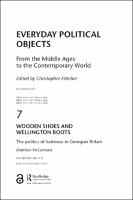Chapter 7 Wooden shoes and Wellington boots
Proposal review
The politics of footwear in Georgian Britain
| dc.contributor.author | McCormack, Matthew | |
| dc.date.accessioned | 2021-07-14T09:48:35Z | |
| dc.date.available | 2021-07-14T09:48:35Z | |
| dc.date.issued | 2021 | |
| dc.identifier.uri | https://library.oapen.org/handle/20.500.12657/50010 | |
| dc.description.abstract | This chapter therefore makes a case for a political history of shoes, by bringing together these two rich fields. It will begin by thinking about the nature of political culture in the eighteenth century, where political virtue was evaluated in highly moral and gendered terms, and where shoes became the focus of debates about masculinity and citizenship. It will then turn its attention to citizenship in a national sense, to think about how certain types of leather shoes came to be seen as synonymous with Britishness, and how wearing them informed what it meant to live as a ‘Briton.’ Debates about politics and gender were inseparable from those on social class, and shoes worn by different social classes were loaded with political meaning. They also give us an insight into how people from different social classes moved and comported themselves. Focusing on the history of shoes in these ways can therefore show how embodiment should be central to our understanding of the practice of politics in eighteenth-century Britain. | en_US |
| dc.language | English | en_US |
| dc.subject.classification | thema EDItEUR::N History and Archaeology::NH History | en_US |
| dc.subject.classification | thema EDItEUR::N History and Archaeology::NH History::NHD European history | en_US |
| dc.subject.classification | thema EDItEUR::N History and Archaeology::NH History::NHB General and world history | en_US |
| dc.subject.other | Ages, Christopher, Contemporary, Everyday, Fletcher, Middle, Objects, Political, World | en_US |
| dc.title | Chapter 7 Wooden shoes and Wellington boots | en_US |
| dc.title.alternative | The politics of footwear in Georgian Britain | en_US |
| dc.type | chapter | |
| oapen.identifier.doi | 10.4324/9781003147428-7 | en_US |
| oapen.relation.isPublishedBy | 7b3c7b10-5b1e-40b3-860e-c6dd5197f0bb | en_US |
| oapen.relation.isPartOfBook | a9a5645b-117c-46f1-90ec-06d725b3b248 | en_US |
| oapen.relation.isFundedBy | 143e059c-d417-47c8-8c3a-9be803199eab | en_US |
| oapen.relation.isbn | 9780367706616 | en_US |
| oapen.relation.isbn | 9780367706609 | en_US |
| oapen.imprint | Routledge | en_US |
| oapen.pages | 17 | en_US |
| peerreview.anonymity | Single-anonymised | |
| peerreview.id | bc80075c-96cc-4740-a9f3-a234bc2598f1 | |
| peerreview.open.review | No | |
| peerreview.publish.responsibility | Publisher | |
| peerreview.review.stage | Pre-publication | |
| peerreview.review.type | Proposal | |
| peerreview.reviewer.type | Internal editor | |
| peerreview.reviewer.type | External peer reviewer | |
| peerreview.title | Proposal review | |
| oapen.review.comments | Taylor & Francis open access titles are reviewed as a minimum at proposal stage by at least two external peer reviewers and an internal editor (additional reviews may be sought and additional content reviewed as required). |

